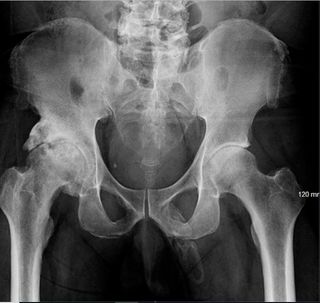Man's X-Ray Reveals His Penis Is Turning to Bone
Sometimes, the body grows bone in places it shouldn't.

Sometimes, the body grows bone in places it shouldn't. That was the case for a man who was diagnosed with an extremely rare condition — his penis was turning to bone, according to a new report.
The 63-year-old man went to the emergency room after he fell on the sidewalk onto his buttocks, according to the report, published in the September issue of the journal Urology Case Reports. He was able to walk, but he told doctors he was experiencing knee pain.
When doctors performed a physical exam, the man also reported penile pain, the report said.
Given that the man had fallen on his butt, doctors decided to first X-ray his pelvis to check for bone fractures. That's when they noticed something very strange: The man appeared to have "ossification" along the entire shaft of his penis, according to the report. In other words, bone had formed inside the penis.
Related: 27 Oddest Medical Case Reports
The man was diagnosed with "penile ossification." The condition is very rare, with fewer than 40 cases reported in the medical literature, according to the report authors, from Lincoln Medical and Mental Health Center in the Bronx, New York; and the American University of Beirut in Lebanon.
Sign up for the Live Science daily newsletter now
Get the world’s most fascinating discoveries delivered straight to your inbox.
Ossification happens when calcium salts build up in soft tissues, "leading to bone formation in areas of the body where there is connective tissue," according to a 2017 report of a similar case published in the journal Reviews in Urology.

Exactly why this happens isn't always clear. But doctors know that penile ossification, though rare, is often linked with another condition called Peyronie's disease, which occurs when scar tissue builds up in the penis, causing the organ to bend or curve. This condition can also cause penile pain with or without erections, according to the Mayo Clinic.
In the current case, the man left the hospital against medical advice, and doctors couldn't perform the tests needed to pinpoint the cause of his condition. But they suspect the man may have had Peyronie's disease, given his report of penile pain and the known link between the two conditions.
Other possible causes can include metabolic diseases, end stage kidney disease or trauma, the authors said.
Treatment for penile ossification depends on the extent of bone formation and the patient's symptoms, the report said. Men who don't have any symptoms typically don't need treatment right away. But those with bothersome symptoms, such as pain, may be prescribed painkillers or receive injections in the penis with certain drugs to reduce pain or curvature. In severe cases, men may need surgical treatment, the report said.
In the 2017 case, a 43-year-old man in Texas went to the doctor because he felt a "firmness" in his penis, and he reported difficulty having erections. The man was diagnosed with Peyronie's disease, and he elected to have an inflatable penile prosthesis, also known as a penile implant, to treat his erectile dysfunction (ED). But while doctors were performing the surgery, they found "calcified tissue" (i.e., bone) in the penis, which was removed with surgery. The man later experienced some complications with his implant, but the device was ultimately successful in treating the man's ED, the report said.
- 7 Surprising Reasons for Erectile Dysfunction
- 5 Myths About the Male Body
- 11 Surprising Facts About the Skeletal System
Originally published on Live Science.

Rachael is a Live Science contributor, and was a former channel editor and senior writer for Live Science between 2010 and 2022. She has a master's degree in journalism from New York University's Science, Health and Environmental Reporting Program. She also holds a B.S. in molecular biology and an M.S. in biology from the University of California, San Diego. Her work has appeared in Scienceline, The Washington Post and Scientific American.
